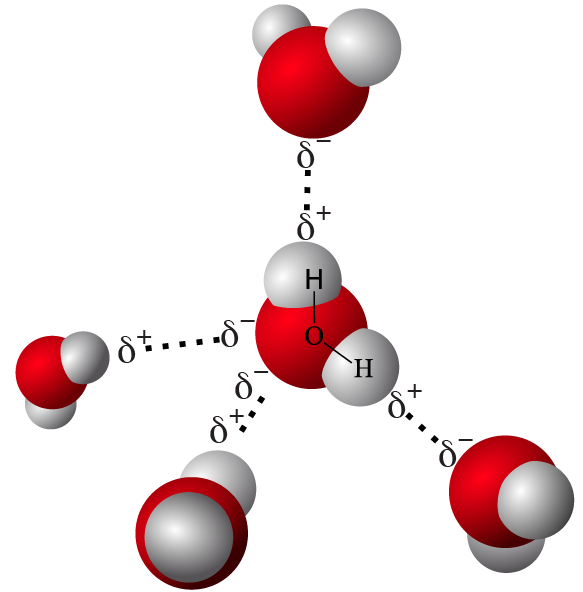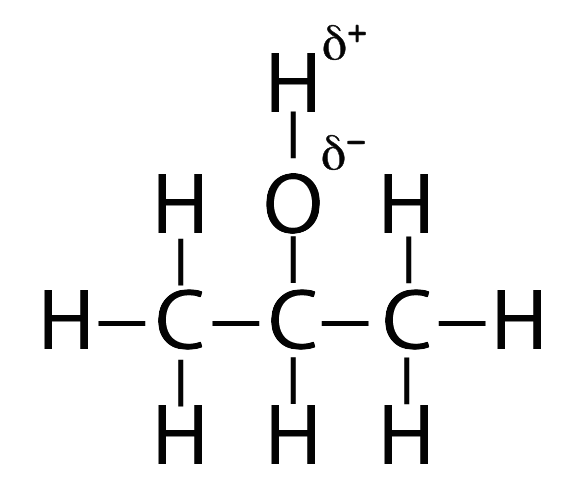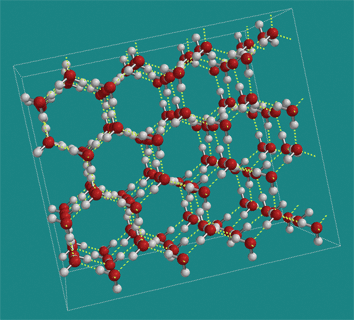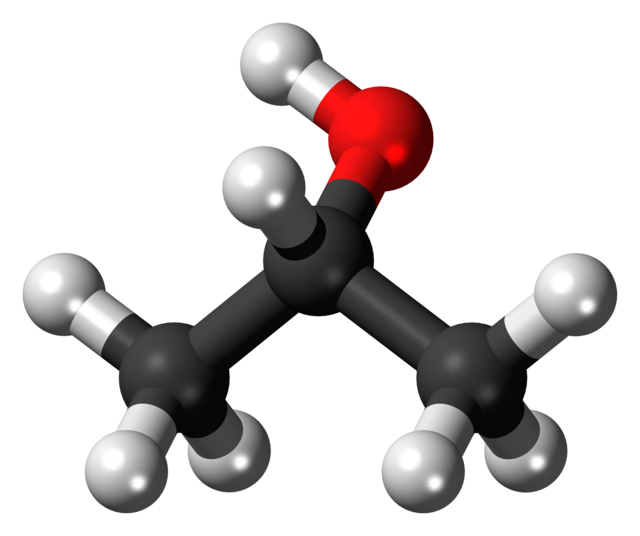Looking for a student learning guide? You’ll find a link on the main menu for your course. Use the “Courses” menu above.
Introduction
In the previous tutorial, we looked at the chemistry of water. We saw how water’s polar structure allows water molecules to form hydrogen bonds with other water molecules. In this tutorial, we’ll do a virtual lab that lets us look at water’s unique properties: properties that result from hydrogen bonding.
1. A (virtual) lab comparing water and alcohol: What you’ll need
To get a sense of the properties of water, we’re going to do a virtual lab comparing water to alcohol. Since real science is always preferable to virtual science, I want to encourage you to get the supplies for this lab and to independently try the activities.
Here’s what you’ll need:
- Tap water
 A small bottle of Isopropyl alcohol. This kind of alcohol is available at almost any supermarket or pharmacy. 90% is the best concentration for this lab.
A small bottle of Isopropyl alcohol. This kind of alcohol is available at almost any supermarket or pharmacy. 90% is the best concentration for this lab.
- SAFETY NOTE: isopropyl alcohol is poisonous. Don’t drink it.
- Also, if you can’t get isopropyl alcohol, but other types of alcohol are available (such as ethyl alcohol), the lab should work perfectly well.
- Two eyedroppers or plastic pipettes. If you’re using pipettes, label them, and put one in the water, and the other in the alcohol. If you’re using droppers, fill one with water, and one with alcohol.
- A few small beakers, glasses, or cups.
- Two small paper clips
- Two pennies (or two small squares of wax paper if you can’t get a penny)
- Two teaspoons to do some stirring
- Table salt (about two teaspoons).
2. Background: Comparing Water and Isopropyl Alcohol
Based on our last tutorial, you already know a lot about water. Here’s a quick review of water’s key properties.
- Water is a polar molecule.
- The oxygen side of the molecule has a partially negative charge (?–)
- The hydrogens, on the other side, have a partially positive charge(?+).
- As a result, water molecules form hydrogen bonds, interacting as shown below.
 |
 |
| Water: structural formula | Water molecules forming hydrogen bonds |
Here’s isopropyl alcohol.
Here’s what you need to know about isopropyl alcohol:
- Most of the isopropyl alcohol (the three carbons and the hydrogens attached to them) is non-polar.
- One part of isopropyl alcohol is slightly polar. It’s the oxygen and hydrogen on top. Notice that in the structural formula on the left, the hydrogen (H) has a ?+ (partial positive charge) next to it, and the oxygen has a ?– (partial negative charge)
So, isopropyl alcohol is slightly polar. But it’s much less polar than water is.
 |
 |
| Water: highly polar | Isopropyl Alcohol: much less polar than water |
Knowing that, let’s do a few experiments where we compare them.
3. Six Observations/Experiments Comparing Water and Alcohol
The experiments that follow are hands-on if you can get the materials. But even if you can’t, making predictions about what will happen will vastly increase the amount that you’ll learn. So get out some paper, and, for each observation that follows, write down your answer before clicking “show the answer.” I guarantee that you’ll learn a lot more if you do.
3.1: A drop of water v. a drop of alcohol
[qwiz style = ” width: 600px !important; min-height: 400px !important; border: 3px solid black; ” qrecord_id=”sciencemusicvideosMeister1961-Virtual Lab: Comparing Water and Alcohol”]
[q] Let’s start by predicting the way that a single drop of water and a single drop of alcohol will look when you put them on a surface like a penny or wax paper. Do the following
- In your notes, draw a picture of how you think a single drop of water on a penny will look, compared with how a single drop of alcohol will look.
- Below your drawing, explain why you think the two will be different.
- Once you’ve made your drawing and prediction, go ahead and experiment if you have materials. Then click “show the answer.”
- If you don’t have the materials, click on “show the answer” to see the results and verify your prediction.
[c]IMKgc2hvdyB0 aGUgYW5zd2Vy[Qq]
[f]IEFOU1dFUg==
CgoK| [Qq]A single drop of water on a penny | A single drop of alcohol on a penny |
Because the water molecules are polar, they grab onto one another through hydrogen bonds. The mutual attraction of water molecules is called cohesion. This cohesion pulls a drop of water into a spherical shape because that’s the shape that allows for the maximum number of bonds. Though gravity is trying to pull all the water molecules down, toward the surface of the penny, the hydrogen bonds keep the water droplet in a spherical shape.
Because alcohol is so much less polar, it can’t resist gravity, and all of the molecules are pulled down into a flat sheet over the penny’s surface.
[/qwiz]
3.2: Piling water and alcohol drops on a penny
[qwiz style = ” width: 600px !important; min-height: 400px !important; border: 3px solid black; ” qrecord_id=”sciencemusicvideosMeister1961-Virtual lab: Drops on a Penny”]
[q]Use what you just observed to predict the following. How many drops of water can you put onto a penny before the water spills over the side? How many drops of alcohol before the alcohol spills over the side. Make a prediction, give it a try, and, most importantly, explain what’s happening.
When you’re ready, click on “show the answer” to see the results and verify your prediction.
[c]wqBzaG93IHRo ZSBhbnN3ZXI=[Qq]
[f]IEFOU1dFUg==
CgoK| [Qq]Water on a penny | Alcohol on a penny |
There are going to be many variables influencing the exact number of drops. The key point is that you should have been able to pile many more drops of water on the penny than drops of alcohol. The explanation here is pretty much identical to the one above. The water molecules have much more cohesion than alcohol molecules because they grab onto one another through hydrogen bonds. Because a sphere allows for the maximum number of connections between water molecules, the expanding drop of water continues to maintain that shape. At a certain point, the sphere expands to where it overflows the penny, and water spills out over the side.
Because alcohol is so much less polar than water, it can’t resist gravity, and all of the molecules are pulled down into a flat sheet over the penny’s surface. This flat sheet can accommodate many fewer drops of alcohol than the hydrogen-bond induced sphere that’s on the penny with water.
[x]
[/qwiz]
3.3: Speed of Evaporation in Water and Alcohol
This video compares the evaporation of a drop of alcohol (left) with a drop of water (right). I used my phone as both a surface and a timer (and then speeded up the video about 60 times, so that each minute on the clock goes by in a second).
[qwiz style = “width: 600px !important; min-height: 400px !important; border: 3px solid black;” qrecord_id=”sciencemusicvideosMeister1961-Virtual Lab: Evaporation”]
[q] Explain why the evaporation times for water and alcohol are so different. Note that it takes about 20 hours for a drop of water to evaporate (I didn’t have enough memory in my camera to film this to completion).
[c]wqBzaG93IHRo ZSBhbnN3ZXI=[Qq]
[f]IEFOU1dFUg==
Cg==VG8gYW5zd2VyIHRoaXMgcXVlc3Rpb24sIHlvdSBuZWVkIHRvIHVuZGVyc3RhbmQgYSBiaXQgYWJvdXQgd2hhdCBldmFwb3JhdGlvbiBpcywgYW5kIHdoeSBpdCBoYXBwZW5zLg==
Cg==JiM4MjIwO0V2YXBvcmF0aW9uJiM4MjIxOyBoYXMgdGhlIHdvcmQgJiM4MjIwO3ZhcG9yJiM4MjIxOyByaWdodCBpbiB0aGUgbWlkZGxlIG9mIGl0LCBhbmQg[Qq]evaporation means becoming a vapor. Imagine a cup of any liquid. All of the molecules in the liquid are in constant motion. The warmer the molecules are, the faster they move. If a molecule at the surface of a liquid is moving fast enough, it can “jump” away from the other molecules in the liquid. When it does, it becomes a gas molecule and becomes part of the air above the liquid.
That’s a general scheme for evaporation of any liquid. Let’s now look at how water and alcohol behaved differently. Obviously, it takes water much more time to evaporate. Why? Because of hydrogen bonding. The water molecules, like the alcohol molecules, are vibrating and moving. But hydrogen bonds keep the water molecules from jumping away from the surface of the drop so that the drop of water evaporates very slowly. Because alcohol is mostly a non-polar molecule (with just a bit of polarity) there’s very little attraction between one alcohol molecule and the next. Consequently, when alcohol molecules accelerate to a high enough speed to jump away from the surface of the liquid, they take off. No hydrogen bonds are holding them back. As molecule after molecule of alcohol jumps away from the liquid, the volume of the liquid decreases…until all of it has evaporated.
The specific property that we’re comparing here is called heat of vaporization: it’s the amount of heat that’s required to make a liquid into a gas. Water’s heat of vaporization is much higher than that of alcohol; the key point is that water, because of hydrogen bonding, has a very high heat of vaporization.
[x]
[/qwiz]
3.4: Comparing How Water and Alcohol Feel on Your Skin
[qwiz style = “width: 600px !important; min-height: 400px !important; border: 3px solid black;” qrecord_id=”sciencemusicvideosMeister1961-Virtual Lab: Drops on Skin”]
[q] Let’s start by predicting the way that a single drop of water and a single drop of alcohol will feel when you place a few drops of each liquid on your skin. Do the following
- In your notes, predict how each liquid will feel when placed on your skin. Below your prediction, explain why you think the two will be different.
- If you have the materials, place the same number of drops of alcohol and water on different areas of your skin (for example, different parts of the back of your hand). If you can, work with a partner, and have your partner place the drops on your hand while your eyes are closed. Without looking, can you tell which drop was which? Afterward, click on “show the answer” to see if your results correspond with what I’ve written below.
- If you don’t have the materials, just click on “show the answer” to see the results and verify your prediction.
[c]wqBzaG93IHRo ZSBhbnN3ZXI=[Qq]
[f]IEFOU1dFUg==
Cg==QWxjb2hvbCBmZWVscyBtdWNoIGNvb2xlciBvbiB5b3VyIHNraW4gdGhhbiBhIGRyb3Agb2Ygd2F0ZXIuIEFzIHlvdSBtaWdodCBiZSBleHBlY3RpbmcsIHRoZSByZWFzb24gZm9yIHRoZSBkaWZmZXJlbmNlIGlzIGh5ZHJvZ2VuIGJvbmRpbmcsIGFuZCB3YXRlciYjODIxNztzIG11Y2ggaGlnaGVyIGhlYXQgb2YgdmFwb3JpemF0aW9uIHRoYW4gYWxjb2hvbC4gQmVjYXVzZSBvZiBoeWRyb2dlbiBib25kcywgdGhlIHdhdGVyIG1vbGVjdWxlcyBhcmVuJiM4MjE3O3QgZXZhcG9yYXRpbmcuIFRoYXQgbWVhbnMgdGhhdCBhcyB5b3VyIGJvZHkgaGVhdCB3YXJtcyB1cCB0aGUgd2F0ZXIgbW9sZWN1bGVzLCB0aGV5JiM4MjE3O3JlIHdhcm1pbmcgdXAsIHRvby4gVGhlIGFsY29ob2wgbW9sZWN1bGVzLCBieSBjb250cmFzdCwgYXJlbiYjODIxNzt0IGNvbm5lY3RlZCBieSBoeWRyb2dlbiBib25kcy4gQXMgdGhleSBhYnNvcmIgaGVhdCBmcm9tIHlvdXIgc2tpbiwgdGhleSBzdGFydCB0byBtb3ZlIGZhc3RlciBhbmQgZmFzdGVyLiBBcyB0aGV5IHN0YXJ0IHRvIGV2YXBvcmF0ZSwgdGhleSBjYXJyeSB0aGVpciBoZWF0IGVuZXJneSBhd2F5IGZyb20geW91ciBza2luLiBZb3UgcGVyY2VpdmUgdGhhdCBsb3NzIG9mIGhlYXQgZW5lcmd5IGFzIGNvb2xuZXNzLg==[Qq]
[x]
[/qwiz]
3.5: Dissolving Salt in Water and Alcohol
[qwiz style = “width: 600px !important; min-height: 400px !important; border: 3px solid black;” qrecord_id=”sciencemusicvideosMeister1961-Virtual Lab: Dissolving Salt”]
[q] Let’s start by predicting how easily salt will dissolve in water and alcohol.
- In your notes, predict whether or not salt will dissolve in water, and whether or not salt will dissolve in an equal amount of alcohol.
- If you have the materials, use two cups.
- place a small amount of water (100 mL) in a cup, and an equal amount of alcohol in a second cup.
- Use one teaspoon to put about 1/2 a teaspoon of salt in the water cup. Stir. Record what happens.
- Using a second teaspoon, put about 1/2 a teaspoon of salt into the alcohol cup. Stir. Record what happens.
- If you don’t have the materials, just click on “show the answer” to see the results and verify your prediction.
[c]wqBzaG93IHRo ZSBhbnN3ZXI=[Qq]
[f]IEFOU1dFUg==
Cg==V2hpbGUgc2FsdCBxdWlja2x5IGRpc3NvbHZlcyBpbiB3YXRlciwgaXQgd29uJiM4MjE3O3QgZGlzc29sdmUgaW4gYWxjb2hvbC4=
Cg==[Qq]
Table salt is sodium chloride (NaCl). Sodium chloride is an ionic compound, held together by ionic bonds between positively charged sodium ions and negatively charged chlorine ions. When water and salt are mixed, water’s polarity makes dissolving the salt easy. The positively charged side of water pulls the chlorine ions away from the salt crystal. The negatively charged side of water pulls the sodium ions away from the salt crystal.
You can see this in the image below, developed by Professor Angelos Michaelides, University College, London. The green spheres are chlorine; the blue spheres are sodium.
In less polar alcohol, the alcohol molecules have no way to “grab” onto the sodium or chloride ions, which stay connected through ionic bonds, and don’t dissolve.
[x]
[/qwiz]
3.6: Floating a paper clip on water and alcohol
[qwiz style = “width: 600px !important; min-height: 400px !important; border: 3px solid black;” qrecord_id=”sciencemusicvideosMeister1961-Virtual Lab: Paper Clip”]
[q] Here’s a final challenge. See if you can float a paper clip on the surface of a cup of water. Then see if you can do the same with alcohol. Here’s the procedure. If you don’t have the materials, read the procedure anyway, and try to predict what will happen in each case.
- Fill a cup with water. To make this easy, use a small cup (but one that’s big enough for a paper clip to float on the surface.
- Use a small paper clip. It’s easiest if you bend up a short metal handle from the paper clip so you can place the clip on the water as gently as possible. Bend it like this
- Gently place the paper clip on the surface of the water, then let go.
- Repeat the same step, except with alcohol in a cup (instead of water)
- If you don’t have the materials, just click on “show the answer” to see the results and verify your prediction.
[c]wqBzaG93IHRo ZSBhbnN3ZXI=[Qq]
[f]IEFOU1dFUg==
CgoK| [Qq]Paper clip: floating on water | Paper clip: sunk in alcohol |
Science is all about repeatable, verifiable results. I can’t definitively say that a paper clip will never float on alcohol. But I’ve had hundreds of students try this over the years, and I’ve never seen one succeed. Here’s what’s happening.
Because water molecules are polar, they connect through hydrogen bonds. They do this at the surface of the body of water (where it contacts the air above it), as well as inside the body of water. So try to imagine that paper clip floating on a web of water molecules (as shown in this image, which is ridiculously not drawn to scale). As long as the clip doesn’t break the web, it can float on top. The name for this web of water molecules on the surface of a body of water is surface tension.
Note that this is not why wood, or aircraft carriers, float on water. Those objects are floating because their overall density is less than that of water (mostly because of trapped space and air inside the wood or the boat). The paper clip, by contrast, is much denser than the water. The floating that you observe in the paper clip is caused by surface tension, not by density.
Alcohol is much less polar than water. Because it’s non-polar, the molecules don’t form hydrogen bonds. Because they don’t form hydrogen bonds, the clips sink through the surface. Essentially, in the alcohol solution, there’s no surface tension (or, at least, not nearly enough to support a paper clip).
[x]
[/qwiz]
4. Summary: Five properties of water that you should remember
Everything you observed in this lab resulted from water’s polarity. Here are the specific properties of water that you should remember from this lab and video.
- Because of hydrogen bonding, water molecules stick to one another. This is a property known as cohesion. We saw this in the shape of a water molecule compared to an alcohol molecule. And we saw this in our demonstration of surface tension. As you’ll see later in this course, cohesion among water molecules explains how 300-foot tall redwood trees can transport water up the length of their trunk. It’s all about each water molecule tugging on the one behind it, all the way up to the top of the tree.
- Water is a great solvent of ionic and polar substances.
- Water has a very high heat of vaporization, which means that it takes a lot of energy to change water from a liquid to a gas. That’s why it takes water so much longer to evaporate than alcohol. Also, when water does evaporate, it removes a lot of heat from the object that it’s evaporating from. This is why perspiration is such an effective way to cool us down. As the water on our skin evaporates, the overall temperature of our bodies is decreased.
- Water has a relatively high freezing point. That’s because when water molecules get cool enough, they’ll grab onto one another through hydrogen bonding. Liquids such as alcohol, which don’t form hydrogen bonds, have to be cooled much more before they’ll form inter-molecular bonds and become solid.
- Water is less dense as a solid than as a liquid. As a result, ice floats on water. This is because when water freezes, the hydrogen bonds generate a crystal matrix in which the molecules are more spread out than when water is in a liquid form. This is a unique property: water might be the only substance whose solid form is less dense than its liquid form.

Source: http://www.computational-chemistry.co.uk/odyssey/gallery_files/ice.gif. Permission pending.
5. Checking Understanding: Properties of Water
[qwiz random = “true” qrecord_id=”sciencemusicvideosMeister1961-Properties of Water Virtual Lab Quiz (M4)”]
[h]Properties of Water Quiz
[i]This quiz is a combination of the game “hangman” and a flashcard deck. With each question, you’ll type in the answer. If you get the question wrong, it goes back in the deck for you to repeat it.
[q] Water is a [hangman] molecule. As a result, water molecules form [hangman] bonds with one another.
[c]cG9sYXI=[Qq]
[c]aHlkcm9nZW4=
Cg==[Qq]
[q]Whereas the [hangman] side of water has a partial positive charge, the [hangman] side of water has a partial negative charge
[c]aHlkcm9nZW4=[Qq]
[c]b3h5Z2Vu
Cg==[Qq]
[q]Because of [hangman] bonding, water molecules have a lot of cohesion.
[c]aHlkcm9nZW4=
Cg==[Qq]
[q]Because of hydrogen bonding, water molecules have a lot of [hangman].
[c]Y29oZXNpb24=
Cg==[Qq]
[q]Isopropyl alcohol is much less [hangman] than water is.
[c]cG9sYXI=
Cg==[Qq]
[q]Because it has less hydrogen bonding, a drop of alcohol will have a much [hangman] shape than a drop of water.
[c]RmxhdHRlcg==[Qq]
[q]The amount of heat required to make a liquid into a gas is its heat of [hangman].
[c]dmFwb3JpemF0aW9u[Qq]
[f]RXhjZWxsZW50LsKgVGhlIGFtb3VudCBvZiBoZWF0wqByZXF1aXJlZCB0byBtYWtlIGEgbGlxdWlkIGludG8gYSBnYXMgaXMgaXRzIGhlYXQgb2YgdmFwb3JpemF0aW9uLg==
Cg==[Qq]
[q]The amount of [hangman] required to make a liquid into a gas is its heat of vaporization.
[c]aGVhdA==[Qq]
[q]The amount of heat required to make a liquid into a [hangman] is its heat of vaporization.
[c]Z2Fz
Cg==[Qq]
[q]Alcohol has a much lower heat of [hangman] than water.
[c]dmFwb3JpemF0aW9u
Cg==[Qq]
[q]Alcohol has a much [hangman] heat of vaporization than water.
[c]bG93ZXI=
Cg==[Qq]
[q]Because of [hangman] bonding, water molecules have a very high heat of vaporization.
[c]aHlkcm9nZW4=
Cg==[Qq]
[q]Because of hydrogen bonding, water molecules have a very high heat of [hangman].
[c]dmFwb3JpemF0aW9u
Cg==[Qq]
[q]Because of hydrogen bonding, water molecules have a very high heat of [hangman].
[c]dmFwb3JpemF0aW9u
Cg==[Qq]
[q]Because water is polar, it’s great at dissolving [hangman] substances like salt.
[c]aW9uaWM=
Cg==[Qq]
[q]Because water is [hangman], it’s great at dissolving ionic substances like salt.
[c]cG9sYXI=
Cg==[Qq]
[q]Because water is polar, it’s great at dissolving ionic substances, and just about any [hangman] substance.
[c]cG9sYXI=
Cg==[Qq]
[q]Because of hydrogen bonding, water has a lot of surface [hangman], enabling a paper clip to float on the surface of a body of water.
[c]dGVuc2lvbg==
Cg==[Qq]
[q]Because of [hangman] bonding, water has a lot of surface tension, enabling a paper clip to float on the surface of a body of water.
[c]aHlkcm9nZW4=
Cg==[Qq]
[q]Because of hydrogen bonding, water has a lot of surface tension, enabling a paper clip to [hangman] on the surface of a body of water.
[c]ZmxvYXQ=
Cg==[Qq]
[q] For water to evaporate, [hangman] bonds need to be broken.
[c]aHlkcm9nZW4=
Cg==[Qq]
[q] For water to [hangman], hydrogen bonds need to be broken.
[c]ZXZhcG9yYXRl
Cg==[Qq]
[q]Because of hydrogen bonding, water freezes at a relatively [hangman] temperature.
[c]aGlnaA==
Cg==[Qq]
[q]Because of [hangman] bonding, water freezes at a relatively high temperature.
[c]aHlkcm9nZW4=
Cg==[Qq]
[q]Because of hydrogen bonding, ice is less [hangman] than liquid water.
[c]ZGVuc2U=[Qq]
[x][restart]
[/qwiz]
Links
- Acids, Bases, and the pH Scale (the last tutorial in this module)

